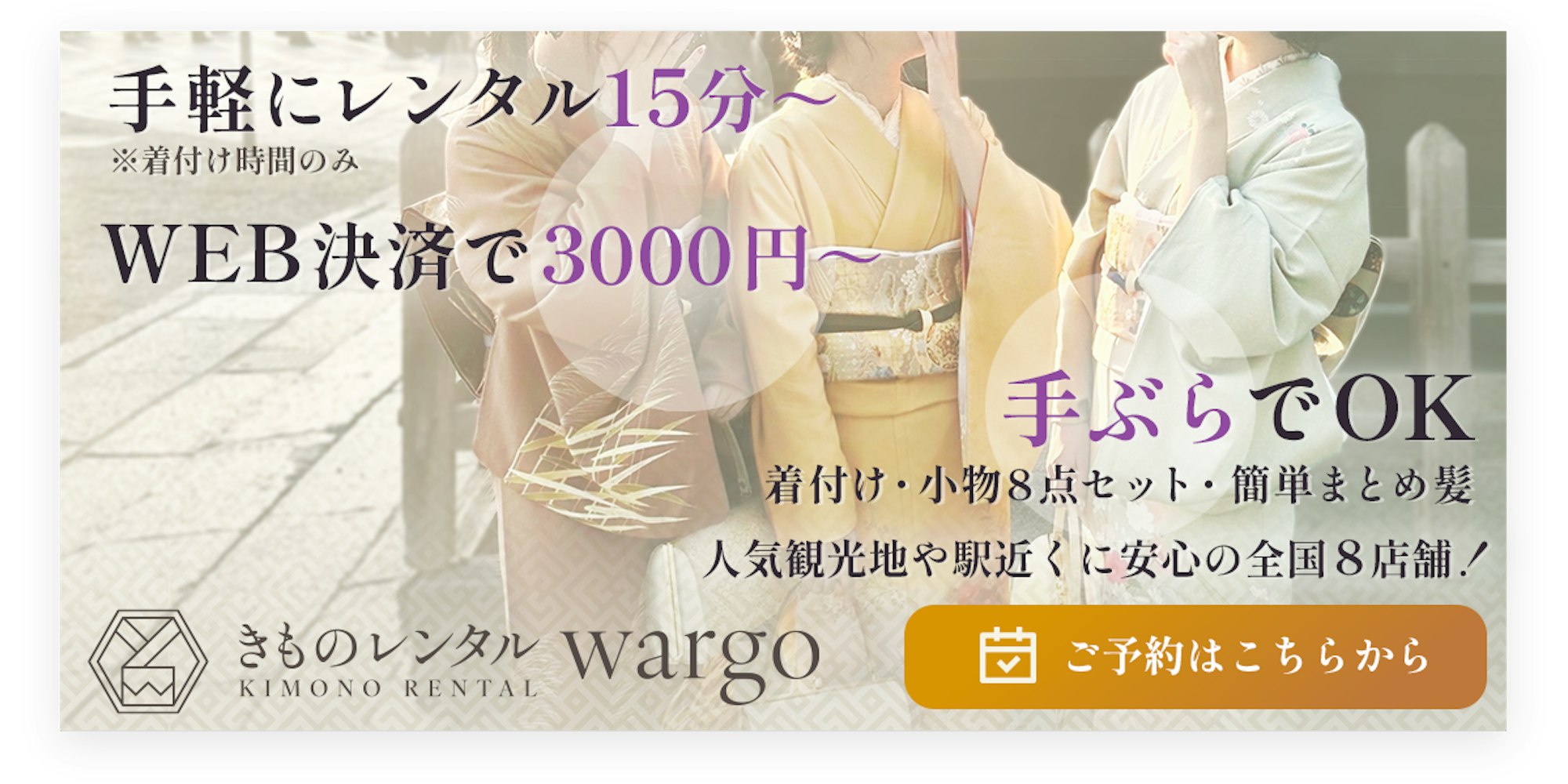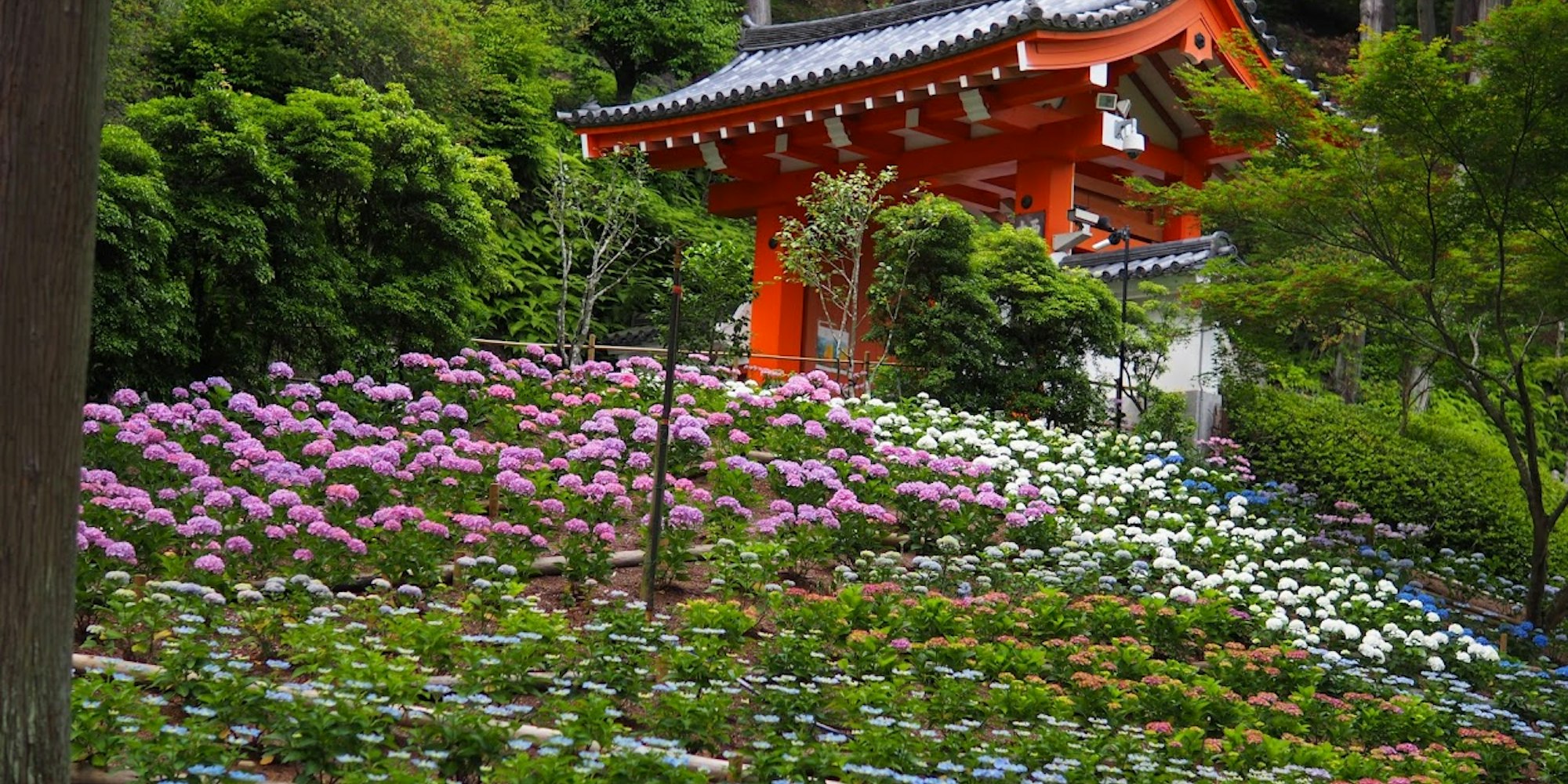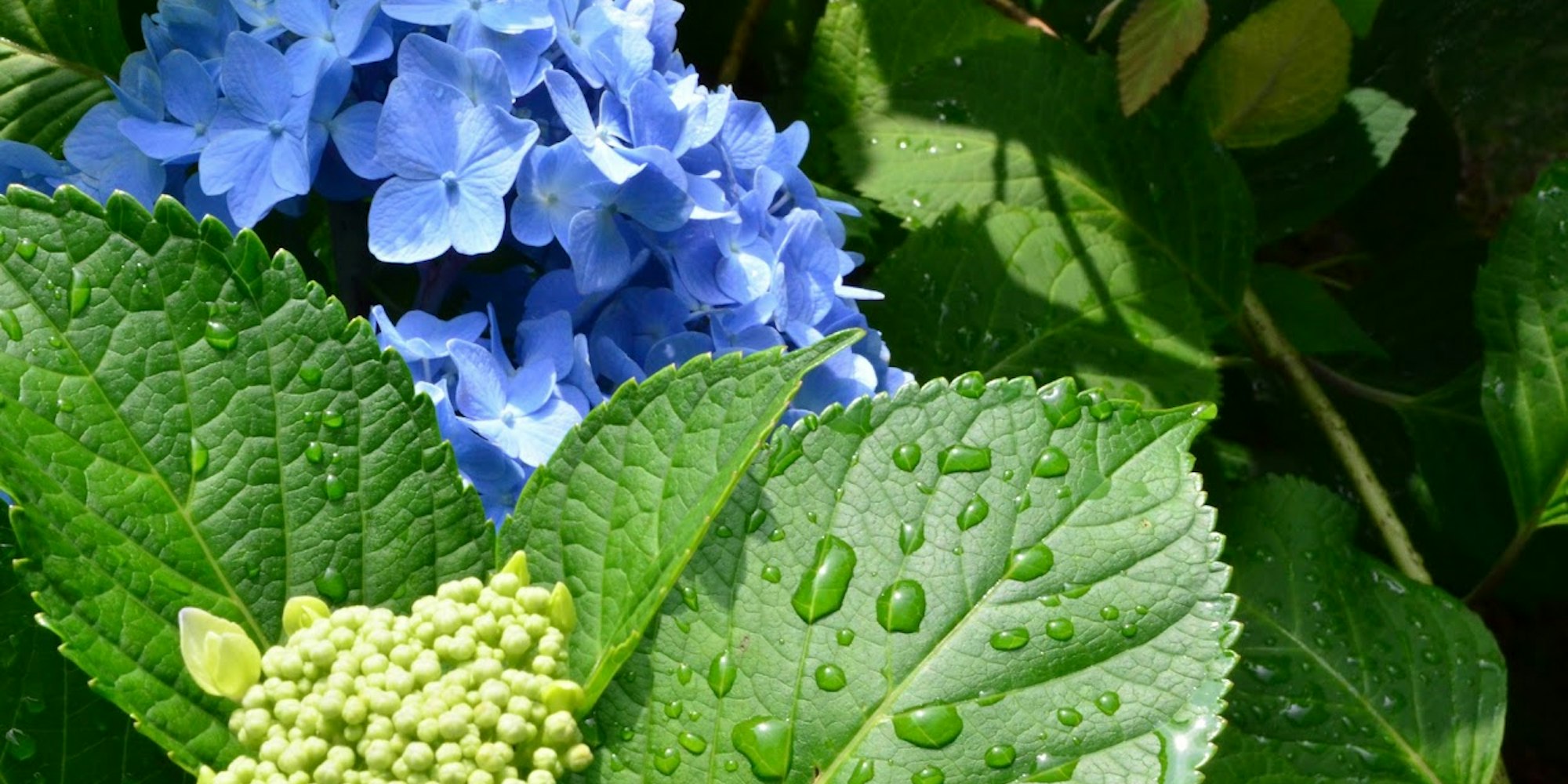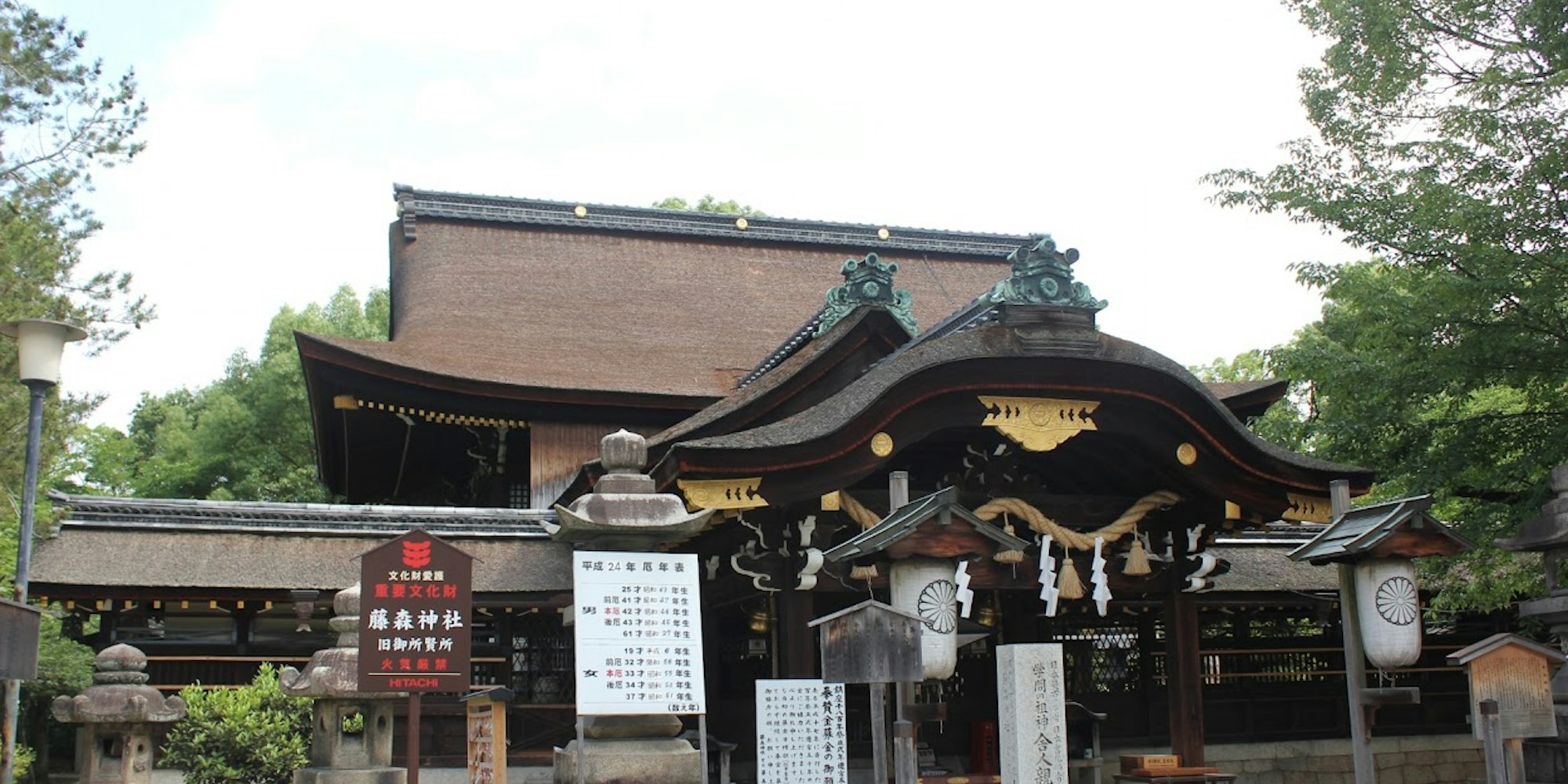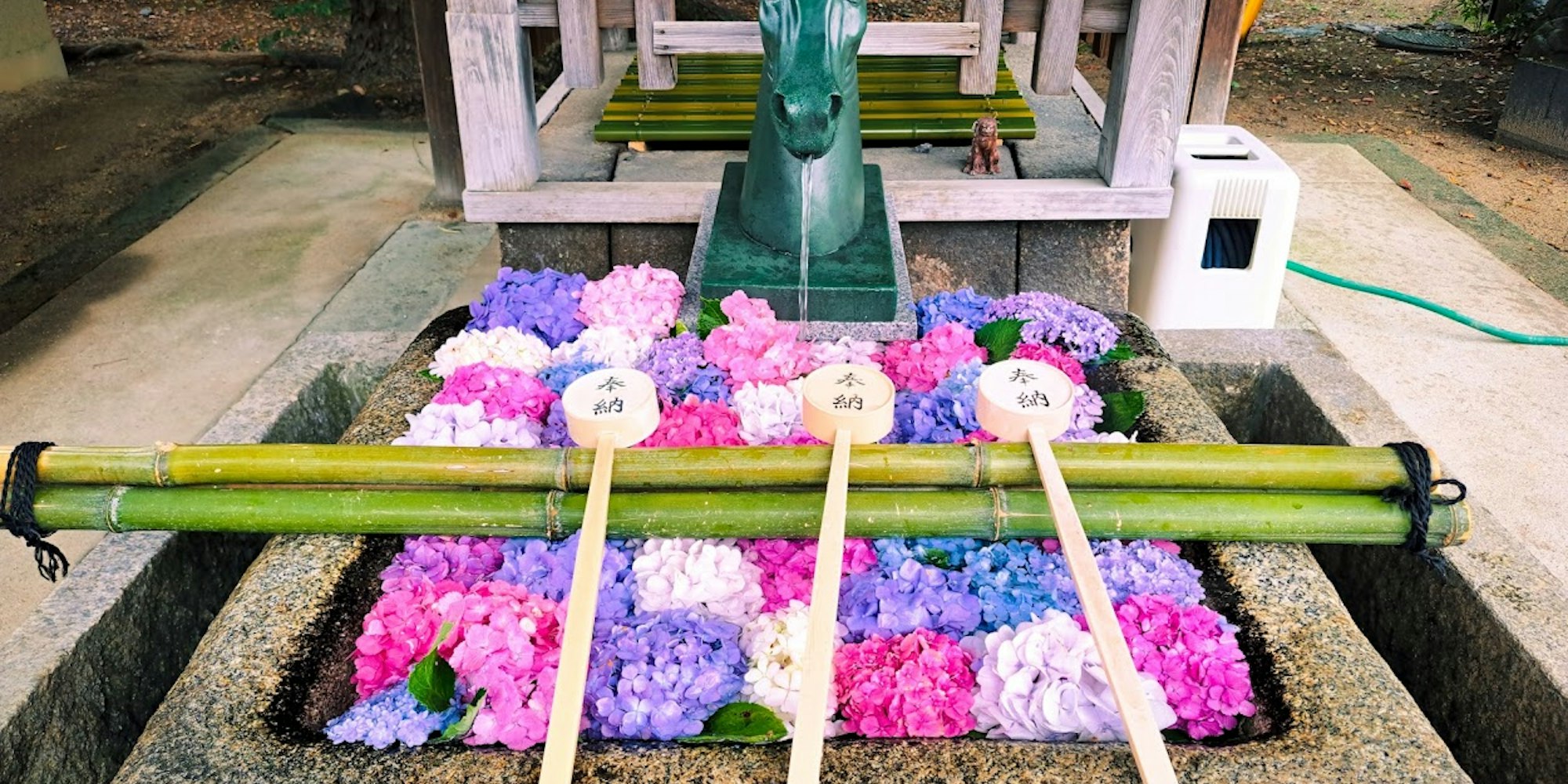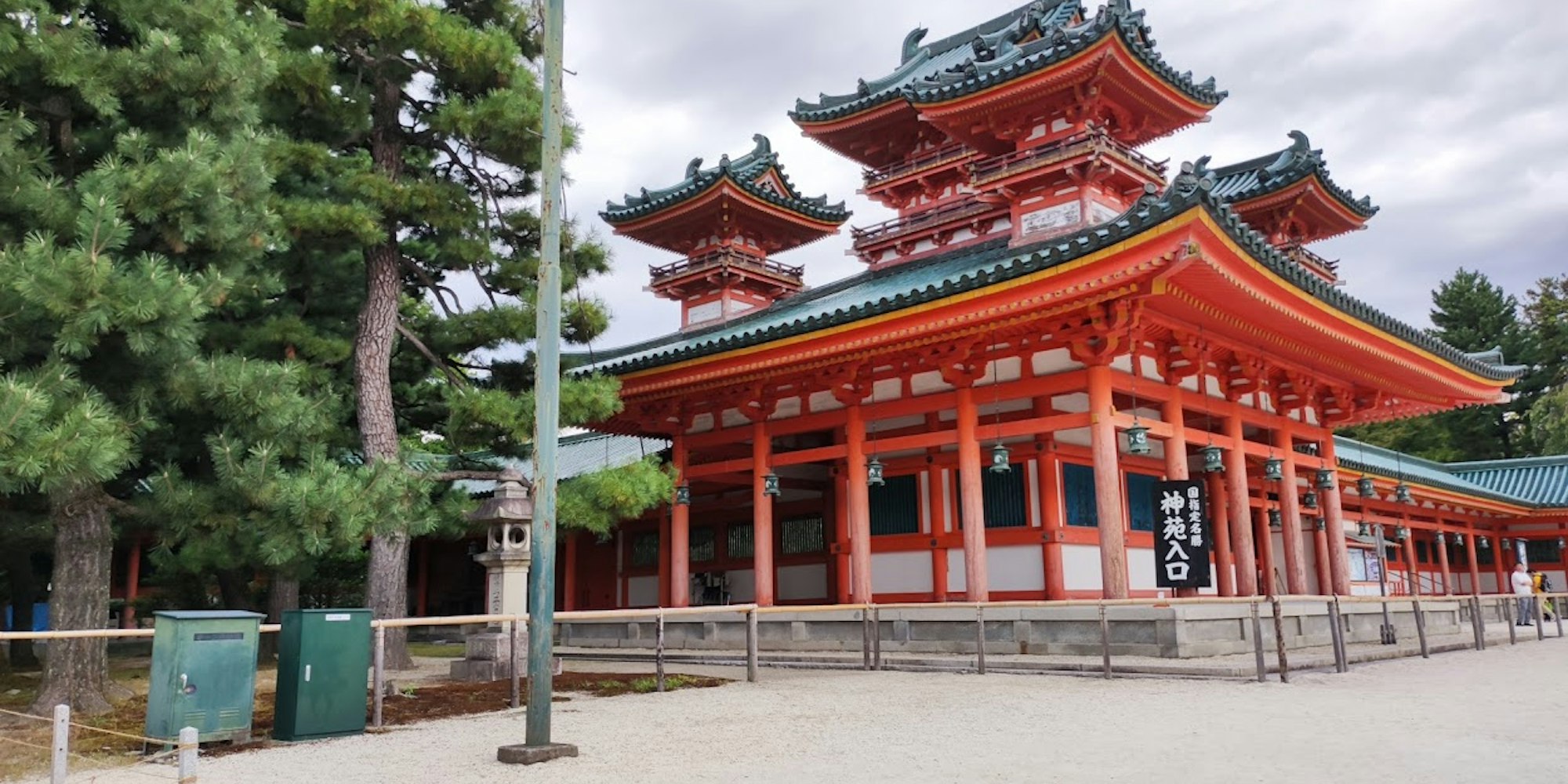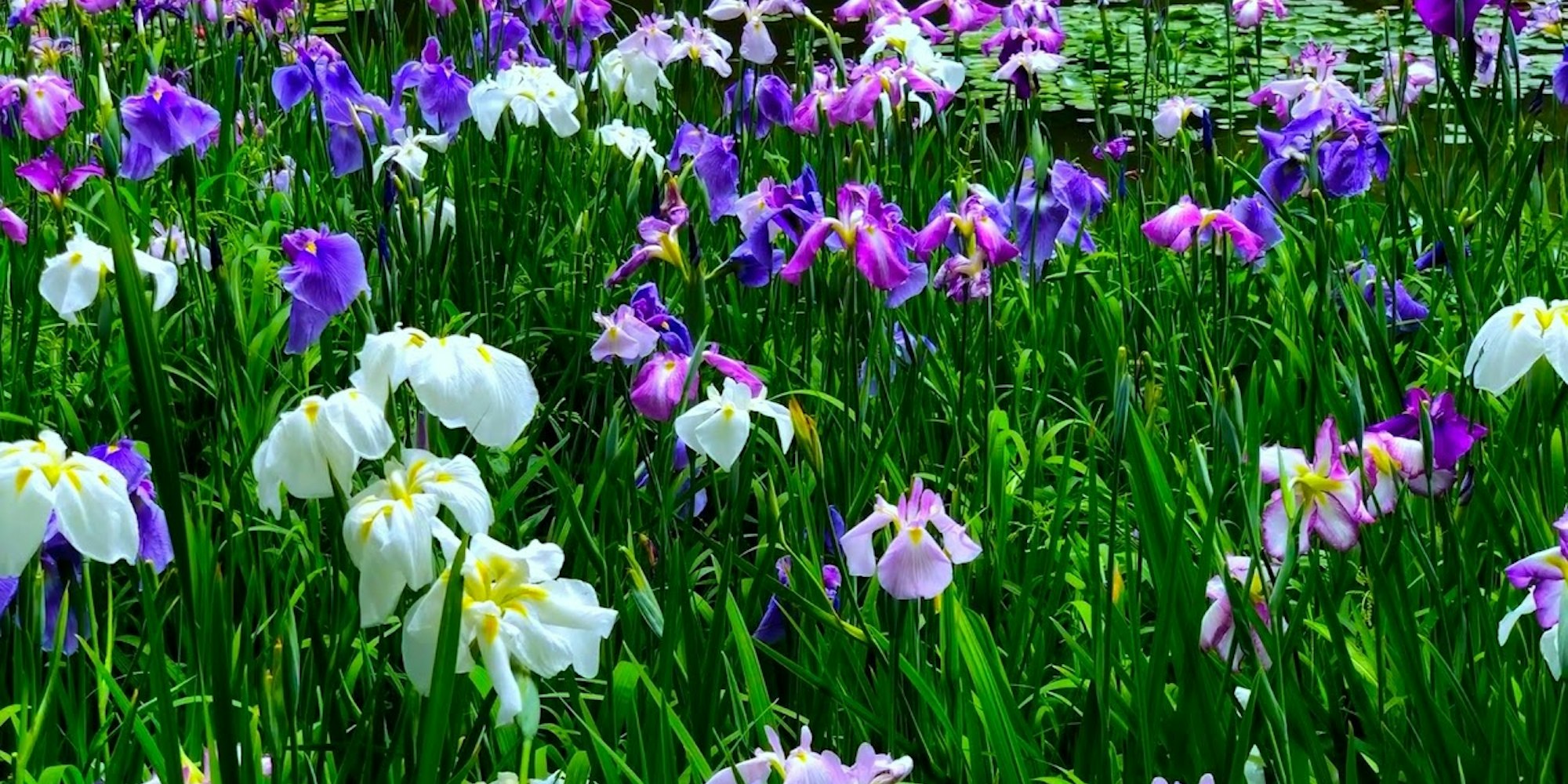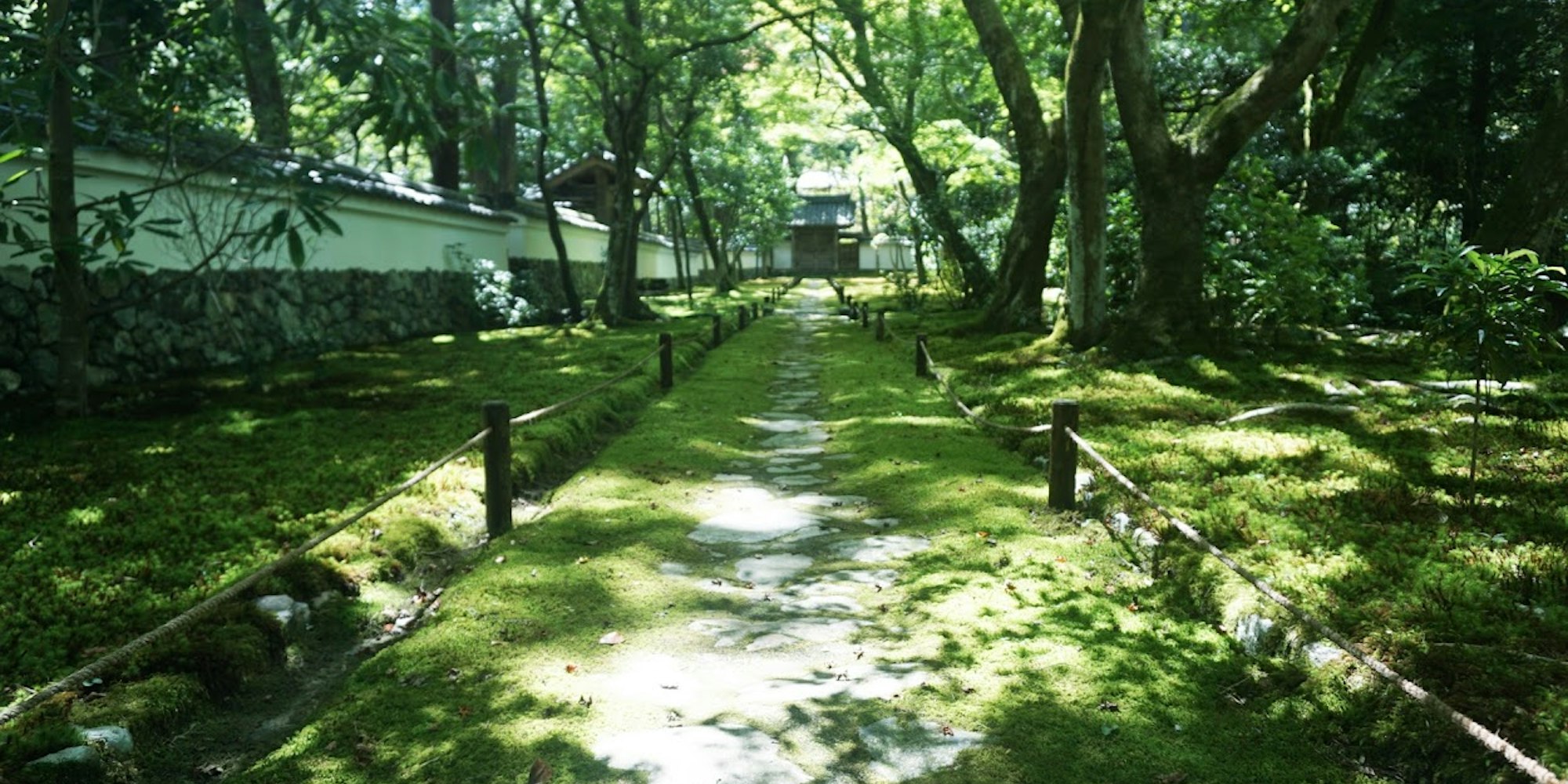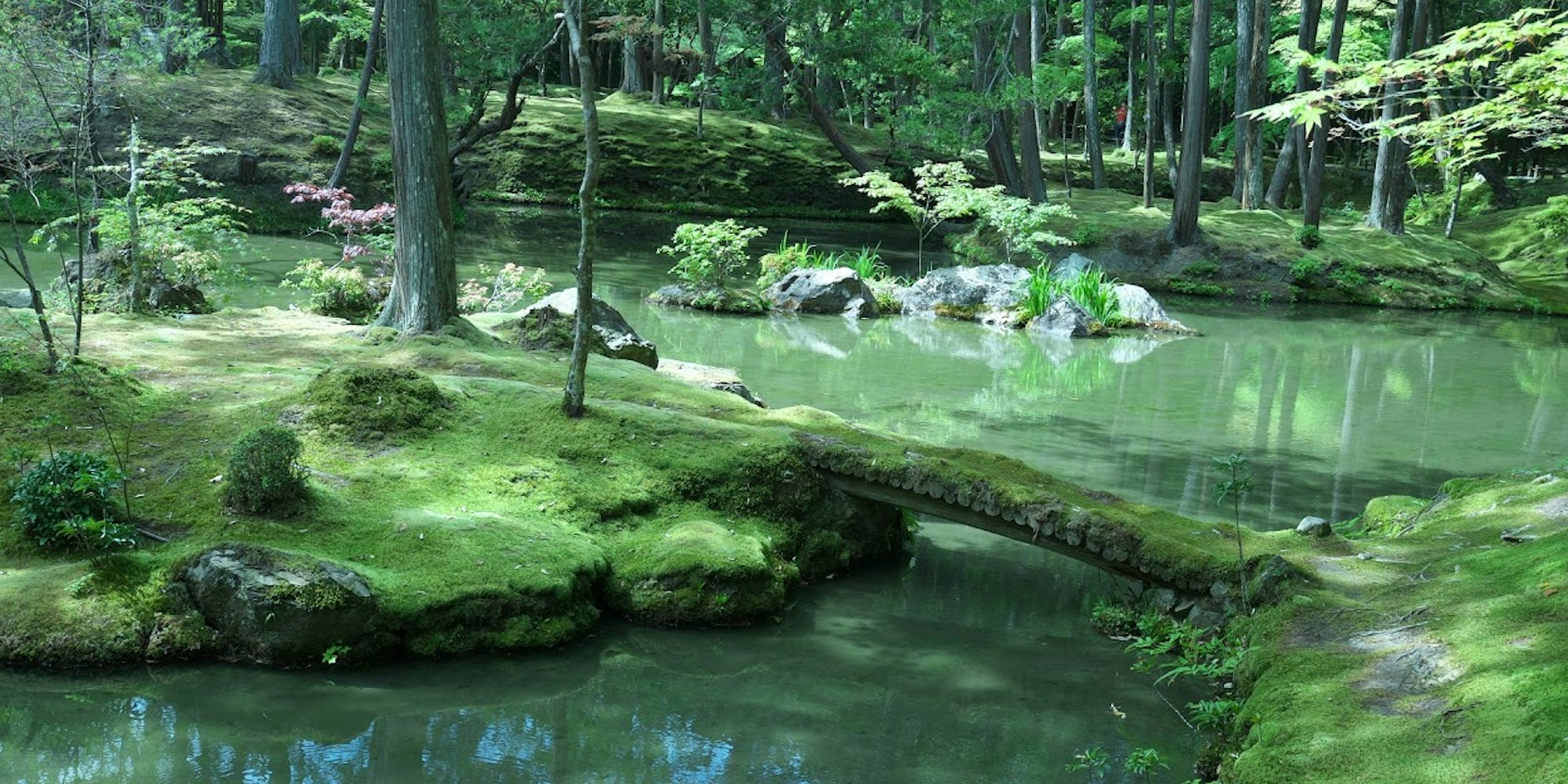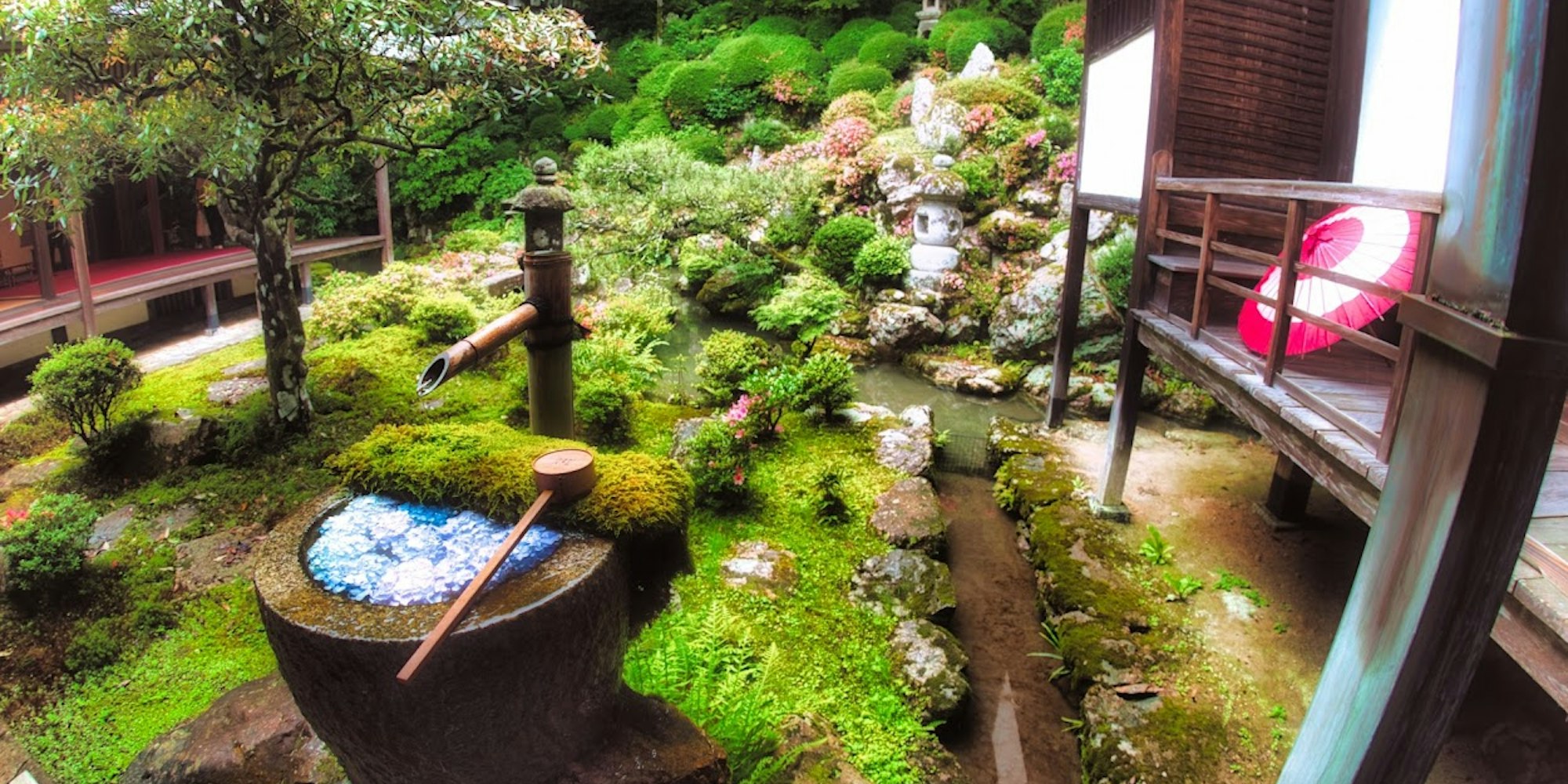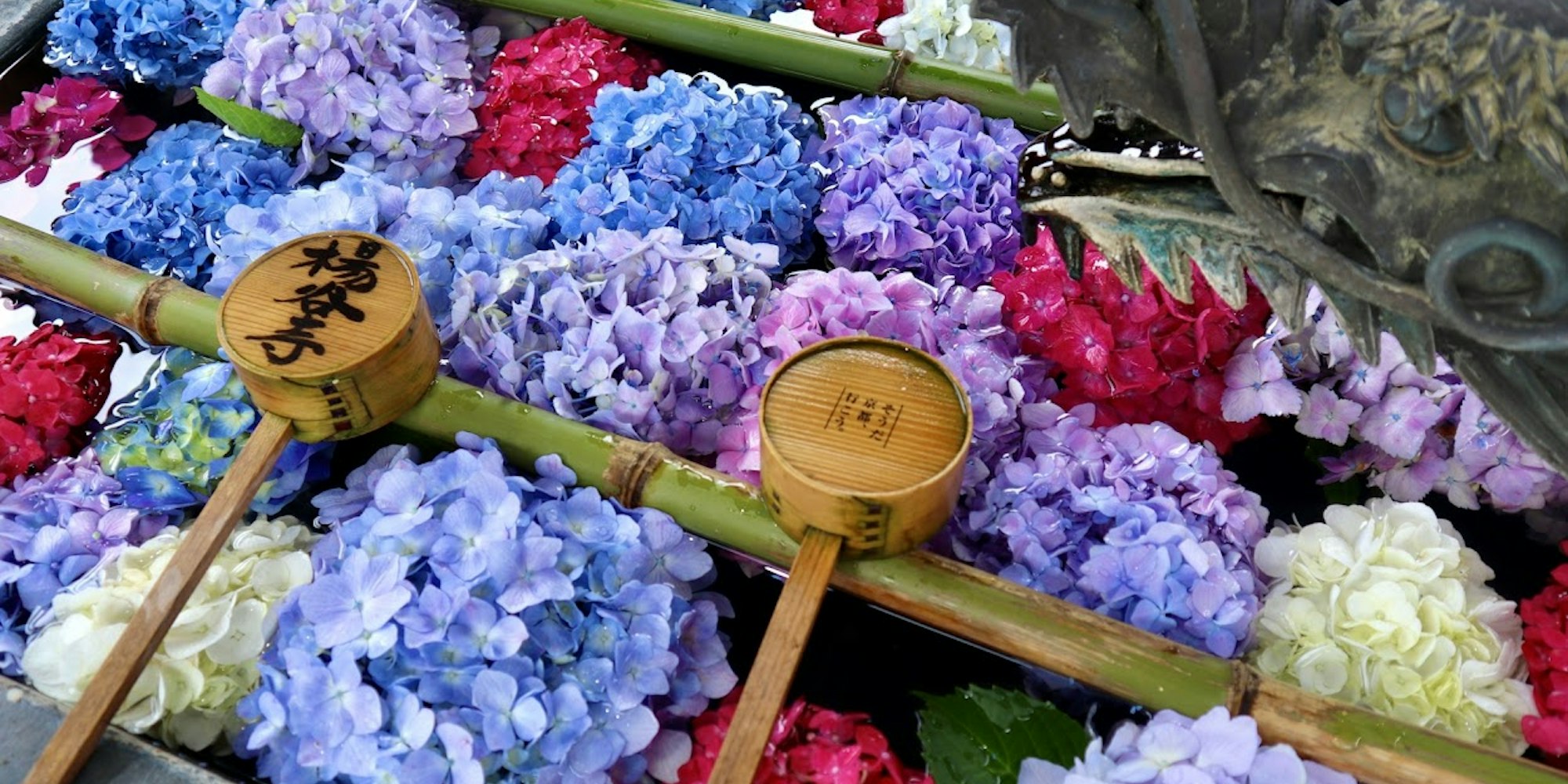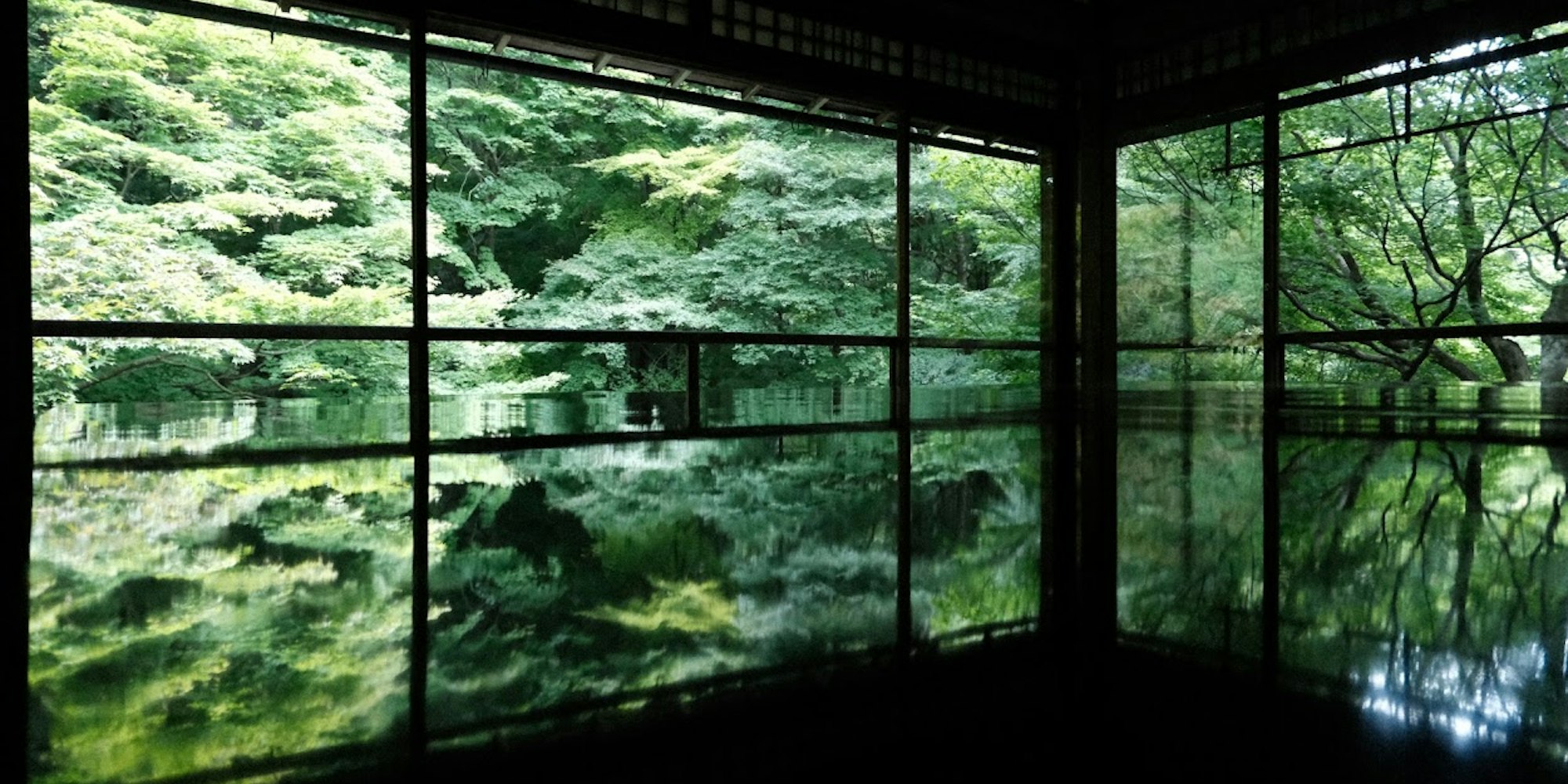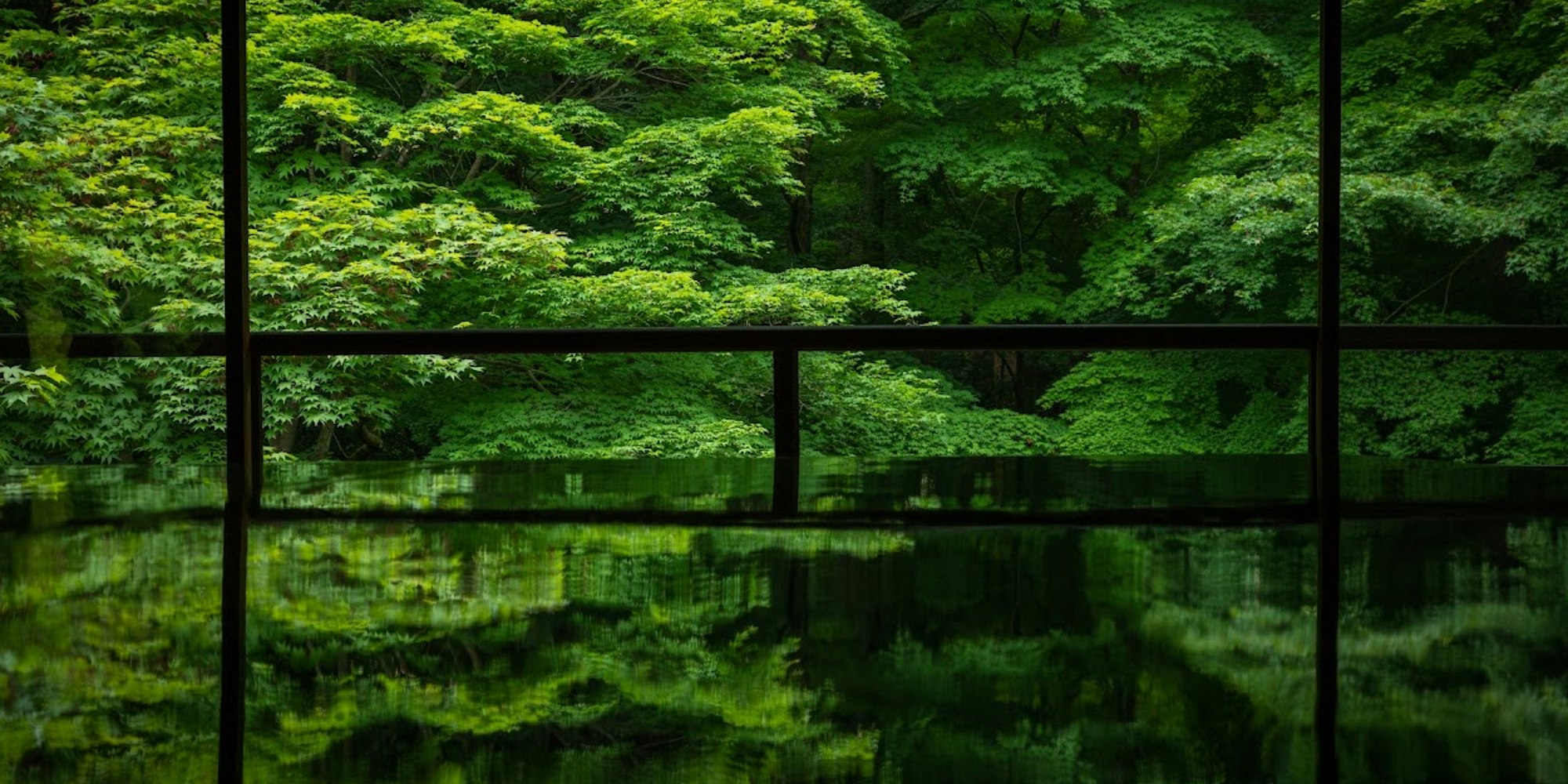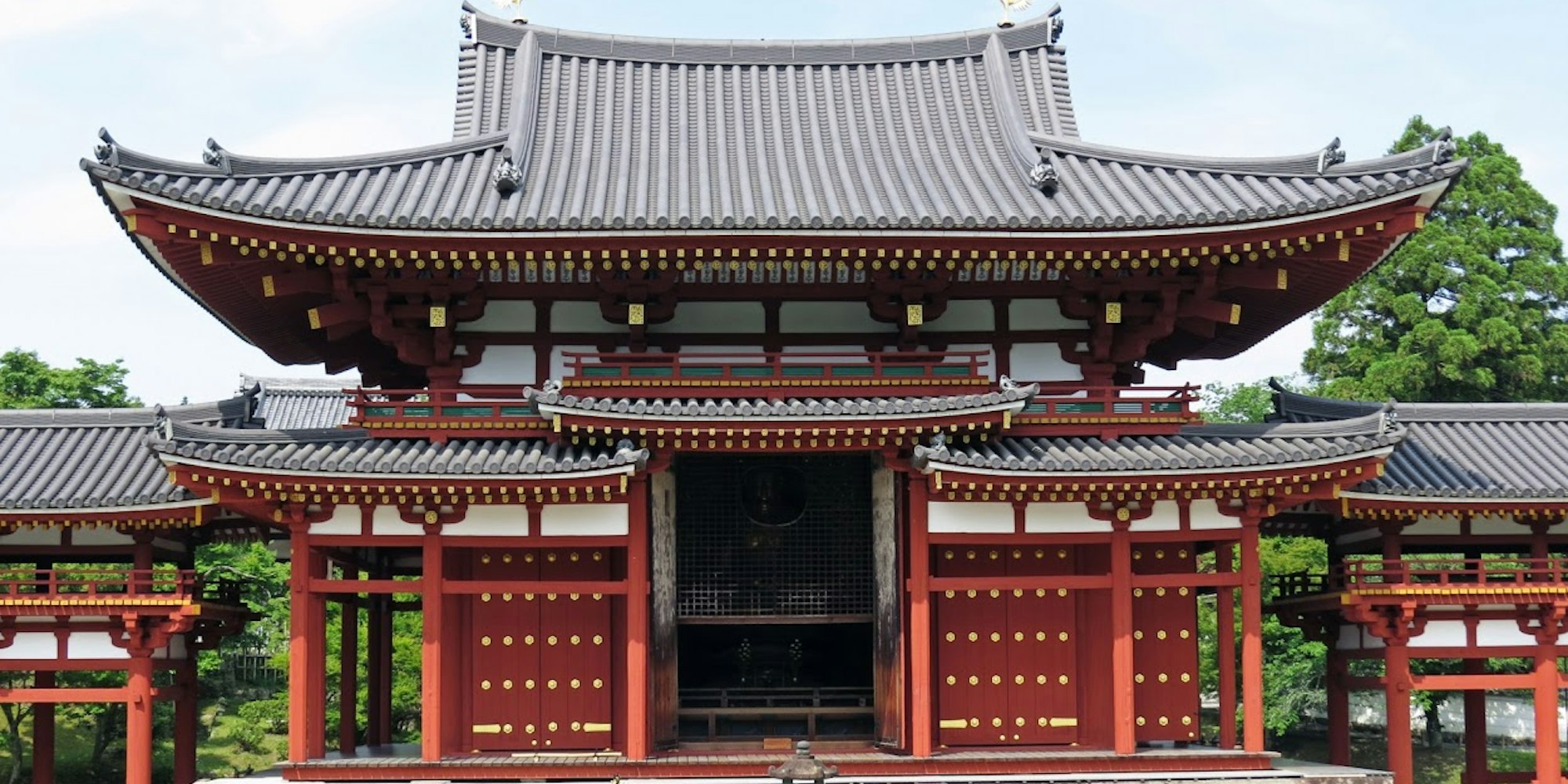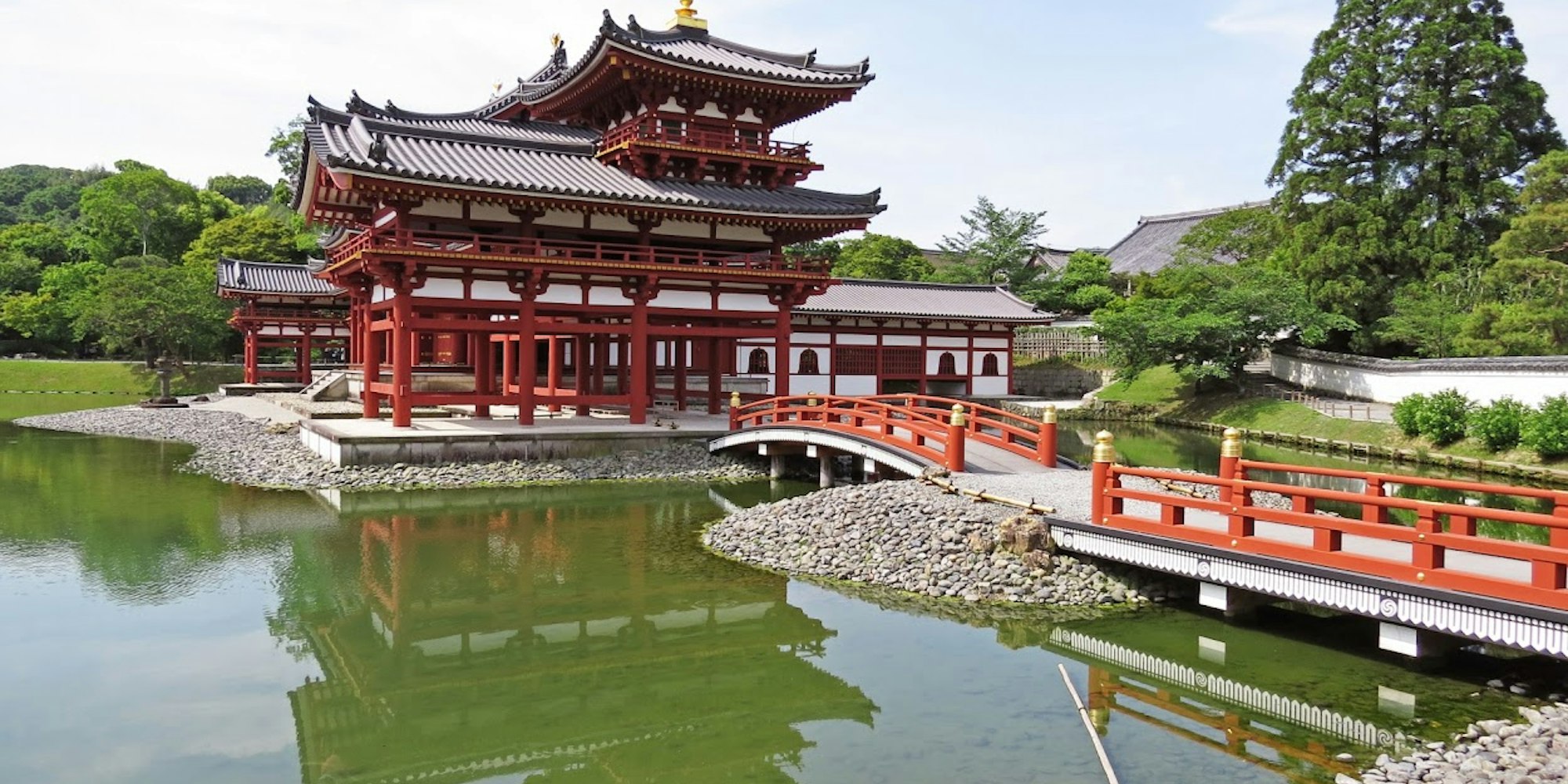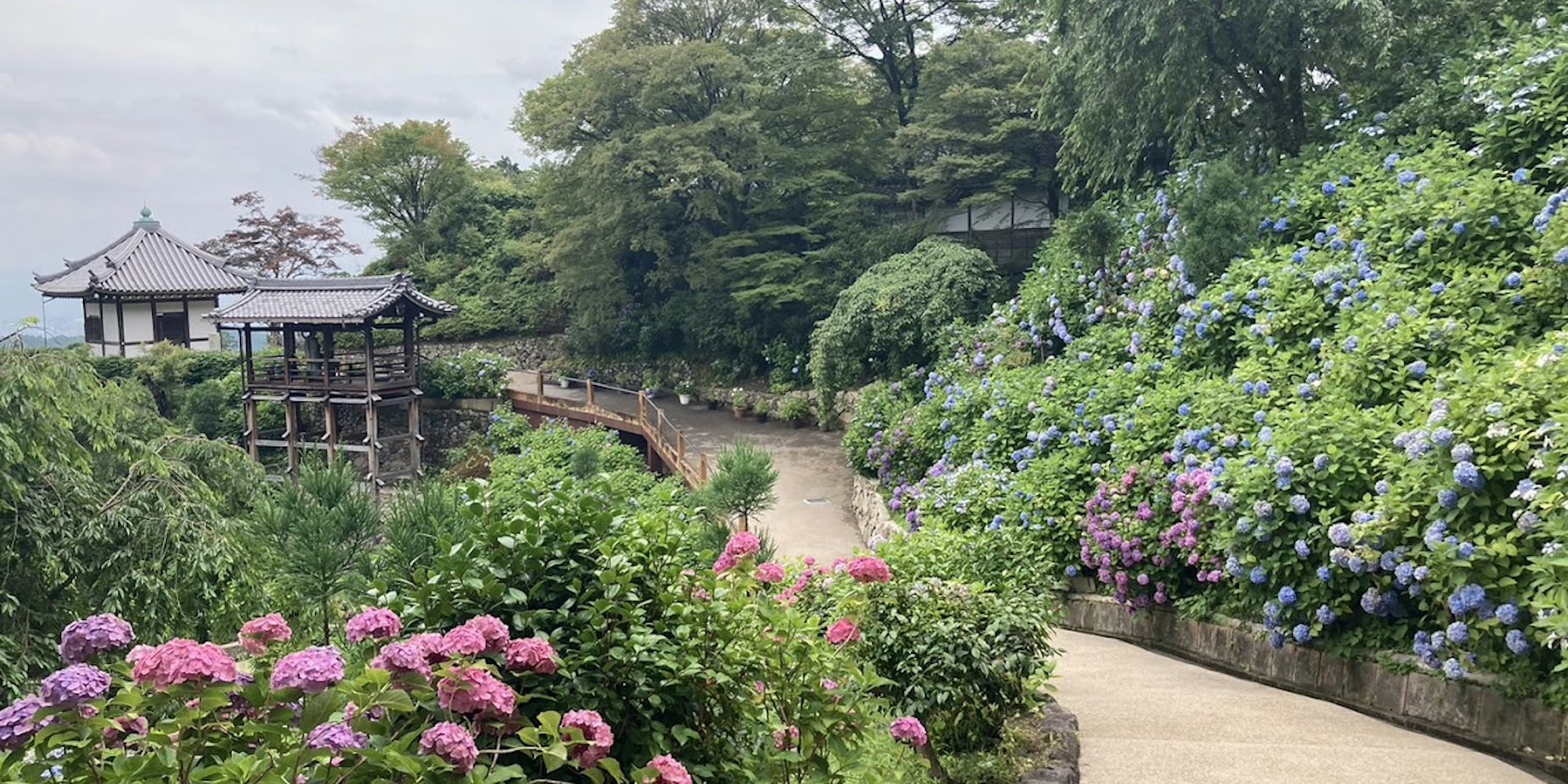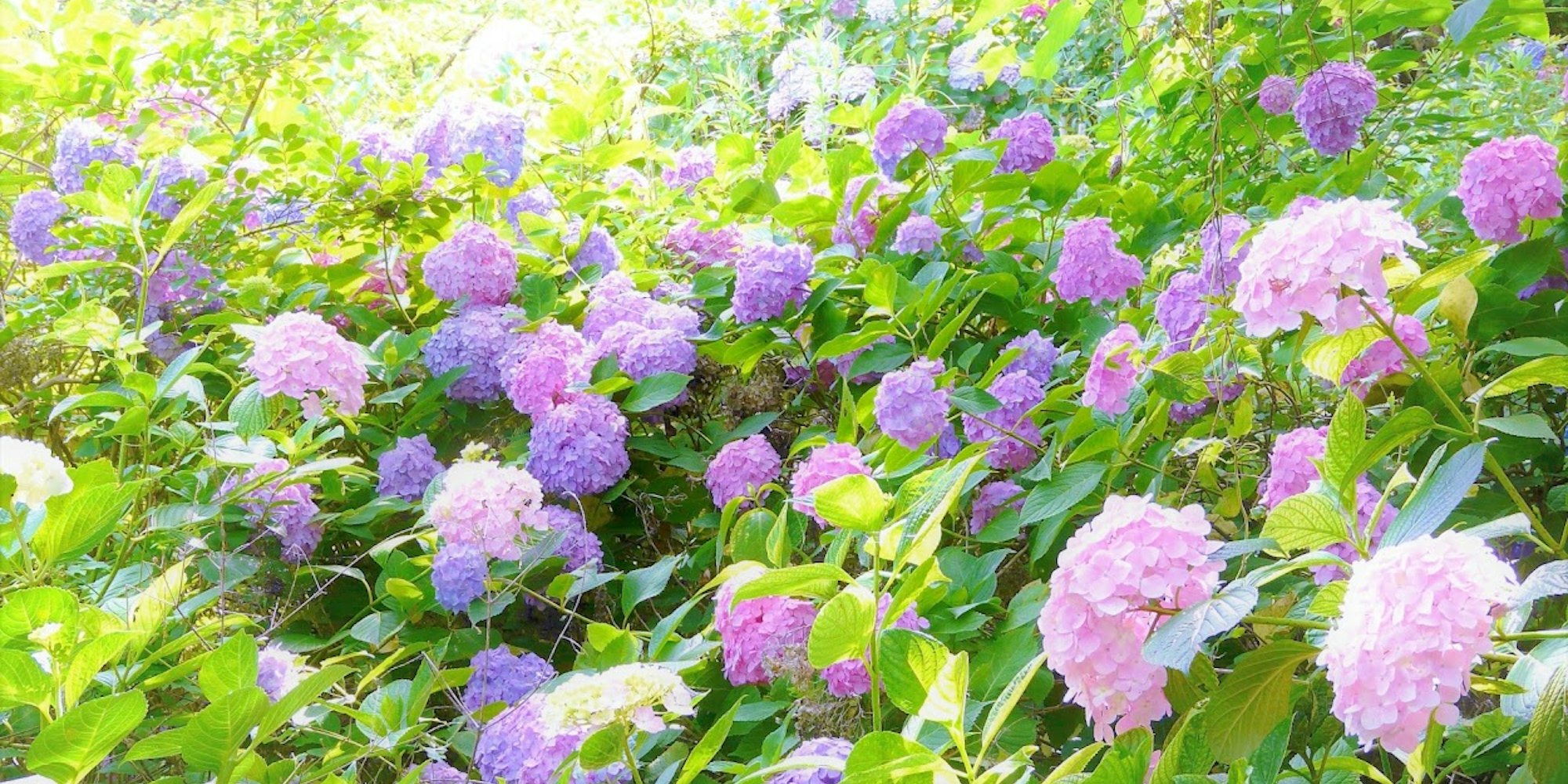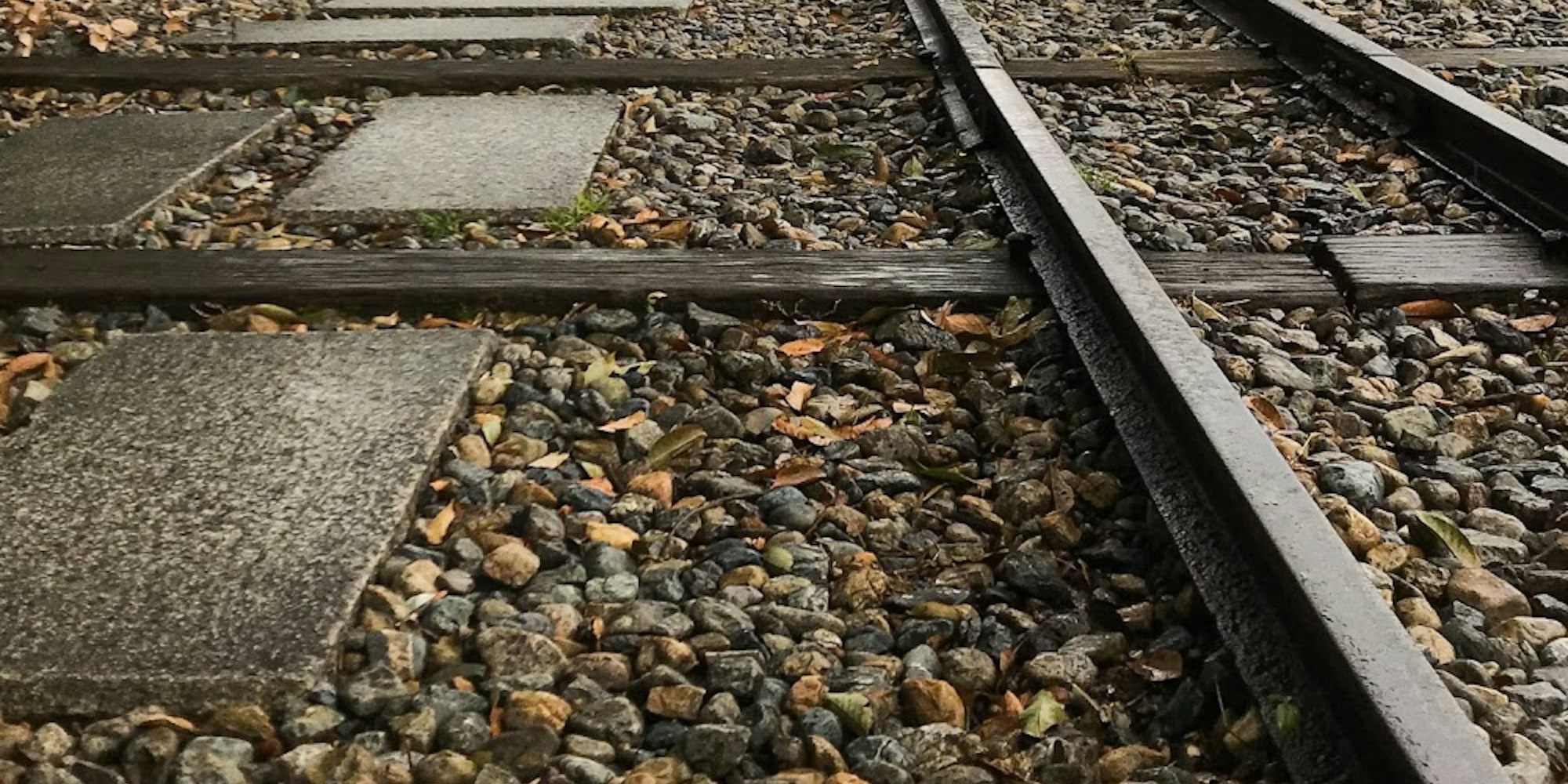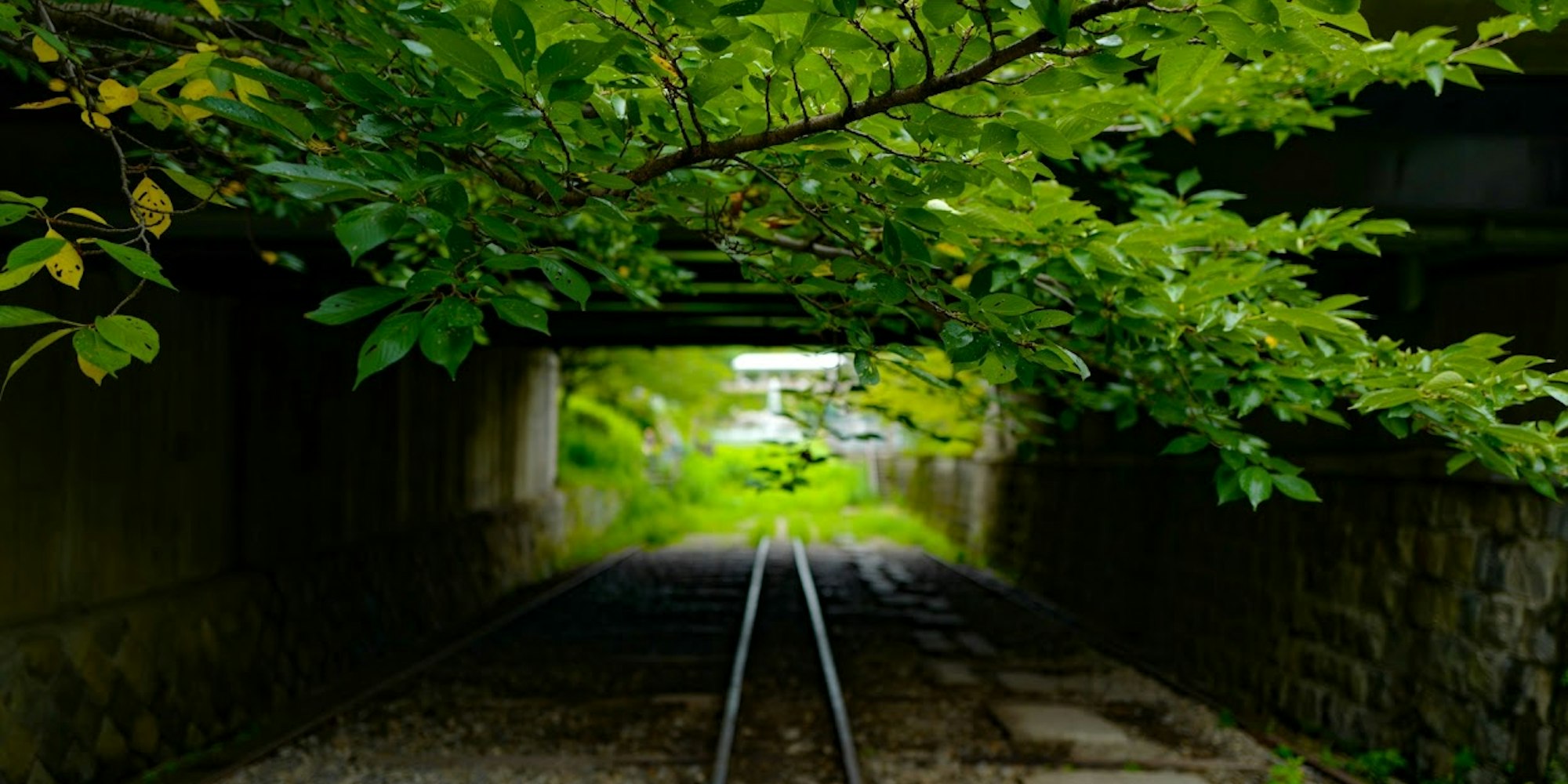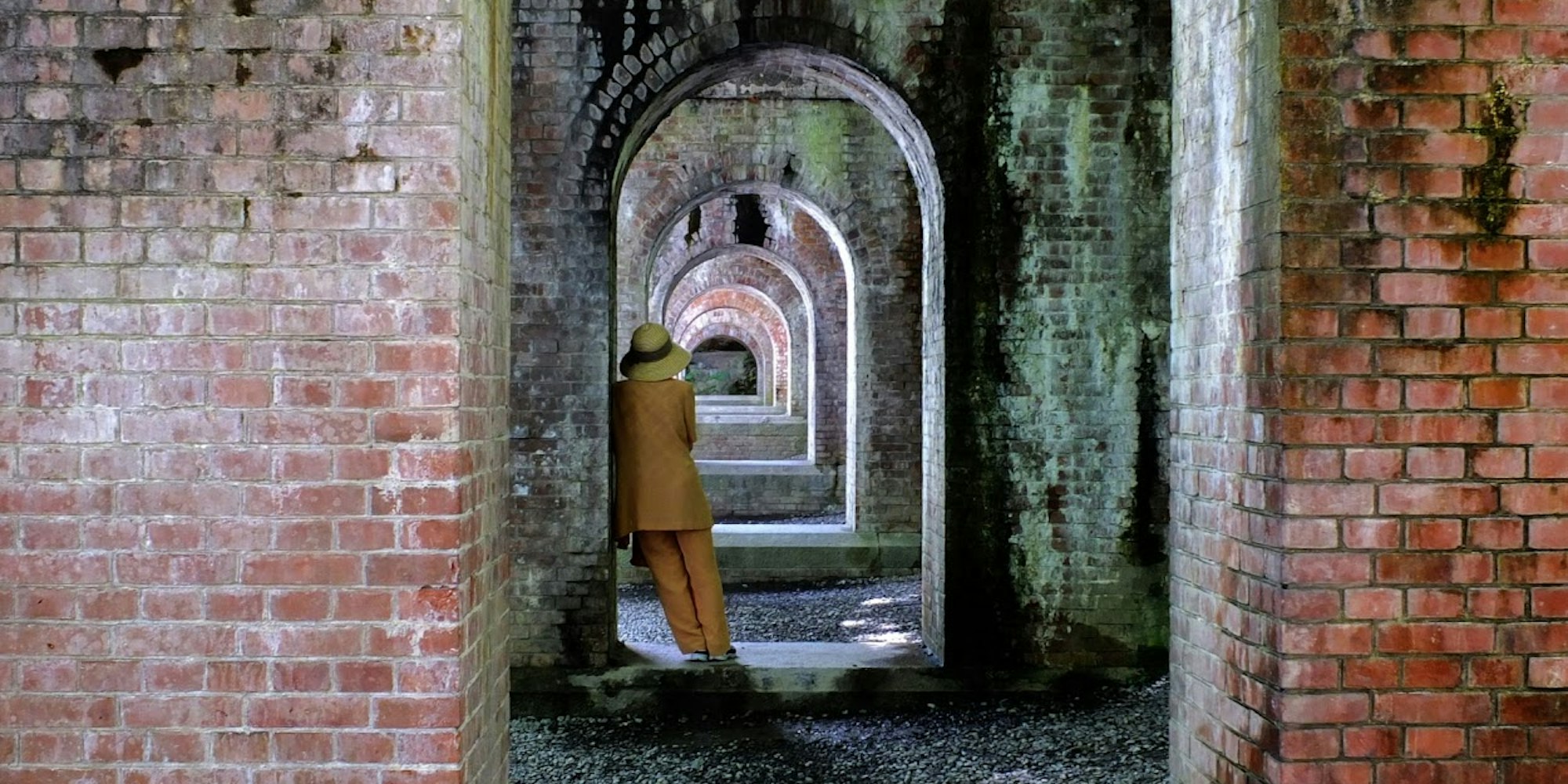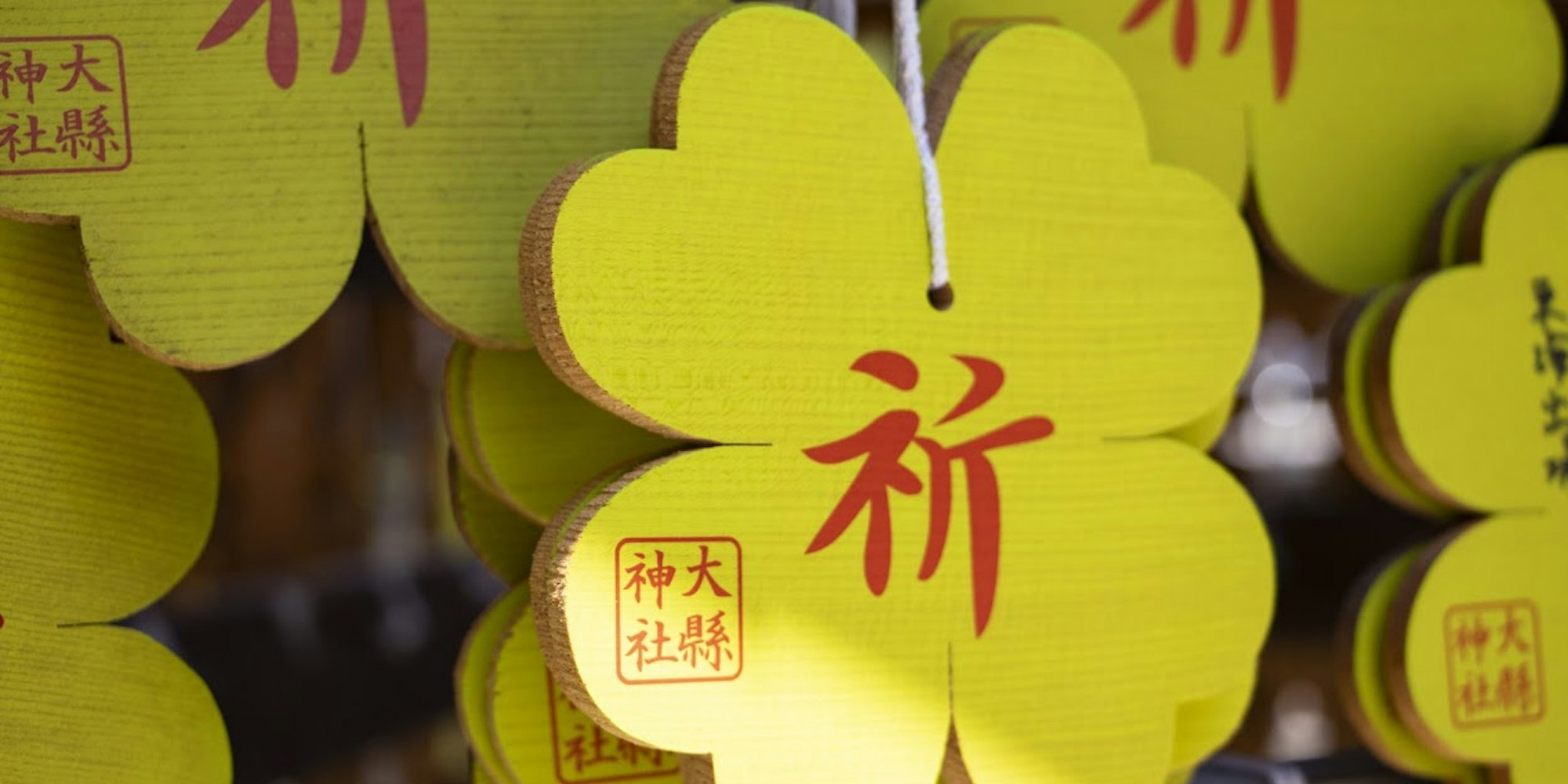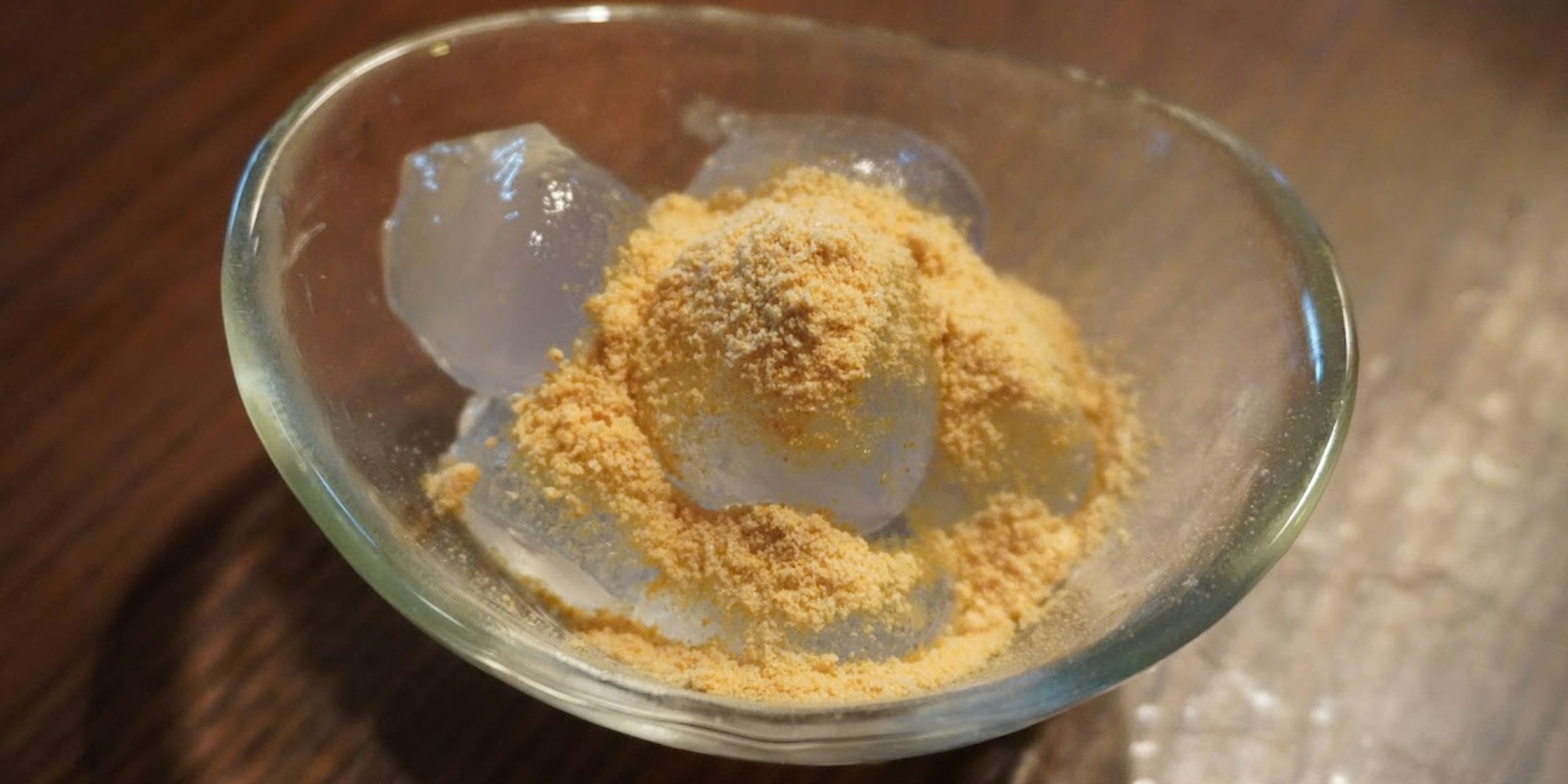Kyoto is a popular tourist destination. However, it can be disappointing if your Kyoto trip is met with rain.
In this article, we'll introduce 10 recommended Kyoto tourist spots that can be enjoyed even on rainy days. We'll also introduce some recommended cafes where you can take shelter if it starts raining during your trip, so please read until the end.
Enjoying June Hydrangeas in the Rain | Mimurotoji Temple
For a June trip to Kyoto, Mimurotoji Temple is recommended as a place to enjoy even in the rain. Also known as the "Hydrangea Temple," Mimurotoji is a must-visit place around June.
With its weeping plum garden, azalea garden, hydrangea garden, and lotus garden scattered throughout, Mimurotoji is an irresistible tourist spot for flower lovers.
Spend a peaceful time admiring the beautiful flowers that remain unchanged from past to present.
June's Hydrangeas are Beautiful in Harmony with the Rain
Mimurotoji is a recommended tourist spot where you can enjoy beautiful June hydrangeas whether it's rainy or sunny. The hydrangeas, which are in full bloom at this time, maintain their beauty even in the rain and match well with the subdued atmosphere.
The "Hydrangea Garden," where colorful hydrangeas bloom in profusion, is open from 8:30 to 15:40. Note that you cannot enter after evening, so be mindful of your visiting time.
Information on Mimurotoji Temple's Opening Hours and Fees
Address: 21 Ogicho Shigadani, Uji City, Kyoto Prefecture
Access: 15-minute walk from Mimurotoji Station on the Keihan Line
Visiting hours: 8:30 to 16:30
Admission fee (Hydrangea Garden): Adults 1,000 yen, Children 500 yen
Official website: https://www.mimurotoji.com/event/hydrangea.html
■ Hydrangea Season is Best
As Mimurotoji is known as the Hydrangea Temple, the best time to visit is during the hydrangea season from June to July. If you're going to visit, aim for when the hydrangeas are in bloom. As it's a famous place for hydrangeas in the Kansai region, it gets crowded on weekends and holidays.
■ Unchanged Beauty Even After 4 Years
I visited in June. It was my first visit in 4 years, but I could enjoy its unchanged beauty. I ended up staying for 3.5 hours. From the flower-decorated water basin to the blooming hydrangeas, it's truly captivating. I had a wonderful time.
Hydrangea Festival Also Held, Best for Seeing Beautiful Kyoto Flowers | Fujinomori Shrine
Fujinomori Shrine is known as a shrine for victory, scholarship, and horses. It's located relatively close to the highly popular tourist spot, Fushimi Inari Taisha, so it's recommended to plan a route visiting both.
Fujinomori Shrine, which holds a hydrangea festival around June every year, has hydrangeas blooming all over the shrine grounds. Also, don't miss the "Hydrangea Goshuin" (special stamp) that's only available during the hydrangea season. Why not choose between red and blue and receive one as a memento?
The Hydrangea-Decorated Water Basin is Charming
During the hydrangea season, the water basin at Fujinomori Shrine becomes an adorable flower-decorated basin with lush hydrangeas.
Although it's the place to purify your hands and mouth first, you'll likely find your spirits lifted. Photography is allowed, so please take a picture of the flower-decorated water basin with a pure heart.
Information on Fujinomori Shrine's Opening Hours and Fees
Address: 609 Fukakusa Toriisaki-cho, Fushimi-ku, Kyoto City
Access: 5-minute walk from JR Fujinomori Station
Visiting hours: 9:00 to 17:00
Admission fee: Free
Official website: http://www.fujinomorijinjya.or.jp/index.html
■ Perfect for Instagram!
I visited Fujinomori Shrine in mid-June! It's perfect for Instagram... I took some photos too! It's really beautiful! The hydrangeas were about 70% in bloom, but the sight of so many hydrangeas in full bloom was impressive.
■ Horses and Hydrangeas...
As it's a shrine for victory and horses, I came to pray for a win in horse racing. I also love flowers, so I decided to come during the hydrangea season. The fully bloomed hydrangeas are colorful, and when gathered together, they have a captivating charm that draws you in.
Japanese Irises in Full Bloom | Heian Shrine
Heian Shrine, famous for its large vermilion torii gate, is a popular tourist spot regardless of the season.
It was founded in 1895 to commemorate the 1100th anniversary of the capital's relocation to Kyoto, with Emperor Kanmu, the 50th emperor, as its enshrined deity. Heian Shrine is the embodiment of the passion and attachment of the citizens who tried to revive Kyoto, which was showing a decline that was almost painful to look at at the time.
The Expanse of Purple Irises is Breathtaking
In June at Heian Shrine, you can see Japanese irises, flowers that have been native to Japan since ancient times, in full bloom. Over 200 Japanese irises bloom in the garden, making it a place where you can fully experience the Japanese atmosphere.
Please come and see the beautiful scenery of elegant purple flowers and vivid green.
By the way, there's a pond in the garden where the Japanese irises bloom, and lotus flowers also bloom there. That's also a scene full of Japanese garden atmosphere, so take your time to look around.
Information on Heian Shrine's Opening Hours and Fees
Address: 97 Okazaki Nishitenno-cho, Sakyo-ku, Kyoto City
Access: 5-minute walk from Okazaki Park Art Museum/Heian Shrine Mae
Visiting hours (Shrine grounds): 6:00 to 18:00
Visiting hours (sacred garden): 8:30 - 17:30
Admission fee (temple grounds): Free
Admission fee (sacred garden): 600 yen (free admission in early June)
Official website: https://www.heianjingu.or.jp/index.html
■ The atmosphere changes completely once you enter the grounds
While the outside has a touristy atmosphere, once you enter, the ambiance changes completely. It feels like time moves slowly in a peaceful atmosphere. Standing in the middle of the spacious grounds, I imagined nobles wearing junihitoe (twelve-layered kimono). The garden in June is beautiful with irises and lotus flowers. It was deeply moving to think that nobles might have enjoyed these same flowers.
■ An elegant place
Although Heian Shrine was founded in 1895, it is still well-maintained and retains its beautiful appearance. I visited in mid-June, and the purple irises were truly elegant, giving a sense of Japanese aesthetics.
Surrounded by beautiful greenery everywhere | Saihoji Temple
Saihoji Temple is a popular spot in Kyoto, known for its moss-covered grounds.
However, advance reservations by return postcard or online are required for visiting. If you want to visit, make sure to book early.
The clear pond, moss, trees, and rocks are all beautiful, making it a place where you can take deep breaths and calm your mind.
A landscape worthy of being called the "Moss Temple"
Also known as "Kokedera" (Moss Temple), Saihoji Temple offers a landscape literally covered in thick moss. From rocky areas to tree trunks, the moss-covered grounds are dyed in a single shade of green, creating a unique scenery not found elsewhere.
On sunny days, the sunlight filtering through the trees is beautiful, but even on rainy days, you can enjoy a fantastical and beautiful view. If you're going to Kyoto in June, be sure to make a reservation and visit Saihoji Temple, also known as the Moss Temple.
Information on Saihoji Temple's opening hours and fees
Address: 56 Matsuo Jingatani-cho, Nishikyo-ku, Kyoto
Access: Right next to Kokedera bus stop
Visiting hours: No information (advance reservation required)
Admission fee: 3,000 yen
Official website: https://saihoji-kokedera.com/
■ Long-awaited visit to the Moss Temple
I visited right after rain. The lush green moss was beautiful, with a moisture not found in dry moss after consecutive sunny days. The overwhelming view of green everywhere was something I had always wanted to see, so I was very satisfied.
■ A quiet experience
Although advance reservations are required, you can spend time quietly and leisurely due to the controlled number of visitors. The moss, wet from the rain, was wonderful.
Excitement over one of the best flower-filled temizuya in Kansai! | Yanagidani Kannon Yokokuji Temple
Yanagidani Kannon Yokokuji Temple is a temple nestled in a quiet mountainous area. Founded in 806, this historic temple is still popular and visited by many people today.
It's also known as a famous spot for hydrangeas, with about 5,000 plants blooming around June. It's definitely a place you'll want to visit with a camera.
Purify your hands at the dragon and hydrangea-filled temizuya
The temizuya (hand-washing basin) at Yanagidani Kannon Yokokuji Temple is known for featuring different flowers each season, with hydrangeas floating in it in June. Proceed to the temple grounds after purifying your hands and mouth while being greeted by lovely silhouettes and colors.
There's also a dragon in the temizuya, so it's recommended to capture it in a photo along with the hydrangeas.
Information on Yanagidani Kannon Yokokuji Temple's opening hours and fees
Address: 2 Joudo-tani Donotani, Nagaokakyo City, Kyoto Prefecture
Access: Take a shuttle bus from JR Nagaokakyo Station
Visiting hours: 9:00 - 17:00
Admission fee: 500 yen
Official website: http://www.yanagidani.jp/
■ Reserved for illumination viewing
I reserved for the illumination viewing this time as well. It was nice to spend time leisurely with fewer people.
■ Hydrangea Week
The sight of 5,000 hydrangea plants in full bloom is overwhelming. The hydrangeas at Yokokuji Temple, loved for so long, are truly impressive and never get old no matter how many times you see them.
Enjoy beautiful scenery while indoors | Rurikoin Temple
Rurikoin Temple is a large temple of about 12,000 tsubo (about 40,000 square meters) with a sukiya-style building and Japanese garden. It's one of Kyoto's most popular spots, attracting many tourists and photography enthusiasts.
With good access from the station, it's recommended for June sightseeing in Kyoto as you can quickly walk there even on rainy days. From spring to summer, you can see the vibrant green color of young maple leaves.
Usually closed for cultural preservation, it's only open to the public during special viewing periods.
Window scenery reflected on black lacquered desks
The most popular spot in Rurikoin is the window scenery reflected on black lacquered desks. The colorful scenery reflected like a mirror is beautiful and photogenic, making it one of the most popular photo spots in Kyoto.
It's recommended to take several shots as even a slight difference in angle or position can result in a different impression. However, please take turns with others when taking photos.
Information on Rurikoin Temple's opening hours and fees
Address: 55 Kamitakano Higashiyama, Sakyo-ku, Kyoto
Access: 5-minute walk from Yase-Hieizanguchi Station
Opening hours: 10:00 - 17:00
Admission fee: 2,000 yen
Official website: http://rurikoin.komyoji.com/lp/
■ Beautiful blue-tinted autumn leaves at Rurikoin Temple even on rainy days
I visited in summer. The beauty was not diminished even in the rain, and I was able to see wonderful scenery. The lush green autumn leaves are beautiful even when wet.
■ A spectacular view of greenery
You can see breathtaking views in any season! Around summer, the greenery was beautiful and soothing. It made me want to see the autumn foliage as well. I enjoyed matcha tea and sweets while viewing the garden.
The Phoenix Hall on the island in the pond stands out even in the rain | Byodoin Temple
Byodoin Temple is a temple founded in the Heian period. It's a place with a long history of about 1000 years, and the entire temple grounds have been designated as a World Heritage site.
The Phoenix Hall (Hoodo), famous from history textbooks, is located on an island in the pond on the premises. Its appearance, as if floating on water, is interesting, and its symmetrical silhouette when viewed from the front resembles a bird with spread wings.
Let's look at the same image as on the 10-yen coin
The Phoenix Hall, which is also designated as a National Treasure, is the one depicted on the familiar 10-yen coin. Please try comparing it with a 10-yen coin in your hand.
In fact, the current phoenix on the Phoenix Hall is the second generation. The first-generation phoenix can be viewed at the Museum Hoshōkan, so please make sure to stop by there as well. You can leisurely experience the history of Byodoin Temple indoors.
Information on Byodoin Temple's opening hours and fees
Address: 116 Renge, Uji City, Kyoto Prefecture
Access: 10-minute walk from JR Uji Station on the Nara Line
Visiting hours: 8:30 - 17:30
Admission fee: Adults 600 yen, Junior and Senior High School students 400 yen, Elementary School students 300 yen
Official website: https://www.byodoin.or.jp/
■ Somehow heartwarming
The plantings behind the Byodoin Phoenix Hall were round and beautiful. I couldn't help but take a picture, but I wonder how it's so perfectly round even though it hasn't just been trimmed... Looking at it made me feel warm inside.
■ I did it
Although I couldn't enter the Phoenix Hall at Byodoin this time, I consider it a success that I was able to take a picture alongside a 10-yen coin. Even just being able to see it from the outside was overwhelming. Next time, I'd like to come again when I have more time.
Overlooking Kyoto with a cluster of hydrangeas | Yoshimine Temple
Yoshimine Temple is a temple believed to offer benefits for curing all illnesses and ensuring peace and safety. Founded in 1029, it enshrines the Thousand-Armed Kannon.
Although it was once destroyed in the Onin War, it was rebuilt in the Edo period and continues to this day.
As the temple is located on high ground, it's also popular as a scenic spot offering a panoramic view of Kyoto City.
A wall-like spread of hydrangea clusters
Yoshimine Temple has about 10,000 hydrangea plants. If you visit around June when they're in full bloom, you can see the hydrangeas in all their glory.
The sight of hydrangeas blooming on the slope looks like a wall, giving a different atmosphere from what you usually see.
Take your time enjoying the view of the colorful hydrangea wall.
By the way, if you visit in other seasons, you can enjoy the 100-year-old weeping cherry tree, the Yuryu Pine, which is the largest pine tree in Japan, and autumn leaves coloring the stone steps and garden.
Information on Yoshimine Temple's opening hours and fees
Address: 1372 Oshio-cho, Oharano, Nishikyo-ku, Kyoto City, Kyoto Prefecture
Access: 8-minute walk from Yoshimine Temple bus stop
Visiting hours: 8:30 - 17:00
Admission fee: Adults 500 yen, High School students 300 yen, Elementary and Junior High School students 200 yen
Official website: http://www.yoshiminedera.com/
■ Surrounded by hydrangeas blooming on the mountainside
When I visited in June, they were in full bloom. Although the mountain path is quite challenging, it was enjoyable to walk while viewing about 10,000 hydrangeas. It's worth the trip to see the hydrangeas covering the mountainside!
■ Atmospheric hydrangeas even in bad weather
Rain can be a good backdrop for hydrangeas! Personally, I prefer it when the weather is a bit bad as it creates a better atmosphere. The day I went to Yoshimine Temple was unfortunately rainy, but I was satisfied because I was able to take good photos.
Aim for shutter chances unique to rainy days | Keage Incline
The Keage Incline is known as one of the most popular photo spots in Kyoto. It was a railway that came into existence in 1881 and is now an abandoned line.
It has been maintained as a historical site, and the 582-meter-long abandoned line is now open for the public to walk on.
On rainy days, it takes on a unique atmosphere, which might actually present more photo opportunities. Please visit to try and capture some Instagram-worthy shots.
Let's walk on a "railway" that's usually off-limits
Most active railways and abandoned lines are off-limits, and it's rare to have the experience of walking on top of them. Entering without permission would be trespassing.
However, since the Keage Incline is an abandoned line that allows entry, you can walk on top of a railway that you normally couldn't. Please try walking along the railway while feeling the excitement like a child.
Information on Keage Incline's opening hours and fees
Address: 339 Higashi-Komonoaza-cho, Higashiyama-ku, Kyoto City, Kyoto Prefecture
Access: 3-minute walk from Keage Station on the subway
Opening hours: Open 24 hours
Fee: Free
Official website: http://www.city.kyoto.lg.jp/suido/page/0000007477.html
■ Enjoy the greenery season at a leisurely pace
Keage Incline is known as a famous cherry blossom viewing spot. While it gets crowded during cherry blossom season, it becomes less crowded and you can walk leisurely when the early summer greenery becomes beautiful a bit later.
■ Ephemeral atmosphere
Take photos at Keage Incline, where the metal of the abandoned railway has a somewhat fleeting feel. The ephemeral atmosphere increases even more on rainy or cloudy days.
A place where romance from the Meiji era remains | Nanzenji Aqueduct
The Nanzenji Aqueduct is a water bridge that passes through the grounds of Nanzenji Temple. Designed to blend in with the scenery of Nanzenji, it has a retro atmosphere.
The bridge, with its impressive series of brick arches, has a sense of use that makes you feel its history, making it a mysterious building. Water from Lake Biwa still flows through it, and it is designated as a historical site of Kyoto City.
Aim for Instagram-worthy retro photos
The Nanzenji Aqueduct, wrapped in a retro atmosphere, is also a popular photo spot. If you try to capture it creatively, you can take photos with a mysterious ambiance.
Japanese clothing looks particularly good in this space that remains as it was in the past. If you're traveling in Kyoto wearing a kimono or yukata, be sure to take photos here. You'll be able to capture unique photos that make you feel like you've time-traveled.
Information on opening hours and fees for Nanzenji Aqueduct
Address: Nanzenji Fukuchi-cho, Sakyo-ku, Kyoto
Access: 10-minute walk from Keage Station on the Tozai Line
Visiting hours: 8:40 - 17:00
Admission fee (Nanzen-in): Adults 400 yen, High school students 350 yen, Elementary and junior high school students 250 yen
Official website: https://nanzenji.or.jp/
■ Photogenic aqueduct!
Although it's a historical structure, it's still actively transporting water! The retro brick arches are very beautiful. It might have a different atmosphere even on rainy days.
■ A spectacular sight to see once in a lifetime!
A retro-style aqueduct. It's often used as a filming location for dramas and is also very popular as a photo spot. This still-active aqueduct is sure to be photogenic!
Festivals held in Kyoto in June
Agata Festival
The Agata Festival is a festival where all roadside lights are extinguished at midnight, and the Bonten procession is carried out in darkness. Also known as the "Dark Night Festival," it's one of the representative festivals of Uji.
Currently, it has become a large-scale event with 500 stalls lined up and attracting about 100,000 people.
Period: June 5 to early morning of June 6
Location: Nakauji area
Nearest station: Keihan Uji Station or JR Uji Station
Kibune Festival
At the Kibune Festival, a golden portable shrine parades through the deep green valley. It's an enjoyable event that feels like a traditional Japanese festival with religious ceremonies, gagaku music offerings, and a portable shrine procession.
Be careful not to confuse it with the festival of the same name in Kanagawa Prefecture.
Date: June 1
Location: Kibune Shrine
Access: 6-minute walk from Kibune bus stop
Kyoto Yoshida Mountain Grand Tea Ceremony
The Kyoto Yoshida Mountain Grand Tea Ceremony is a relatively new event that started in 2010. It's an irresistible event for tea lovers, where about 300 types of tea are gathered and can be enjoyed.
Since rare teas are also sold, be prepared to loosen your purse strings.
Period: First weekend of June
Location: Yoshida Shrine
Access: 10-minute walk from Kyodai Seimon-mae
3 recommended cafes to visit when it starts raining
For Kyoto sweets | ZEN CAFE
ZEN CAFE is a popular cafe in Kyoto with a calm atmosphere. It's recommended to visit when you have plenty of time as you need to get a numbered ticket and wait for about an hour. It might be just right if you're waiting for the rain to stop.
The specialty is the special kuzu-mochi, but there are many other delicious Japanese sweets, so choose the menu that interests you. They pair well with green tea, allowing you to enjoy Japanese sweets.
Stylish sweets that are also Instagram-worthy
ZEN CAFE's Japanese sweets are served in Western tableware, giving them a different look from other sweet shops. They also pay attention to the tableware for drinks, so if you capture them well in photos, they should be Instagram-worthy.
The wall with the shop's logo is also simple yet stylish, so it might be good to take photos with it as well.
Information on ZEN CAFE's opening hours and prices
Address: 570-210 Gionmachi Minamigawa, Higashiyama-ku, Kyoto
Access: 2-minute walk from Gion-Shijo Station
Opening hours: 11:00 - 18:00
Closed on Mondays
Budget: 1,000 to 2,000 yen
■ Popular cafe with modern Japanese style
This cafe has a wonderful modern Japanese atmosphere and serves high-quality Japanese sweets. The sweets have a refined sweetness that even adults can enjoy easily. Recommended for those who want to experience a taste of Kyoto while sightseeing.
■ Crowded but...
After receiving a numbered ticket, there's about an hour wait. It's always crowded since it's a popular cafe, but I keep coming back because I love the quality Japanese sweets and relaxing time.
Embracing Kyoto's atmosphere | eX cafe Kyoto Arashiyama Main Store
eX cafe is a place where you can enjoy the mood of Kyoto sightseeing. Operating in a renovated traditional Kyoto residence, eX cafe is a special cafe where you can experience the essence of Kyoto and Japan.
It's popular as a must-visit cafe, whether it's raining or not.
Relax while viewing a Japanese garden
At eX cafe, which is renovated from a traditional residence, you can enjoy sweets and tea while looking at a Japanese garden.
It's quite elegant to savor Japanese sweets or grilled dango with matcha tea while viewing the Japanese garden. If you want to experience something truly Kyoto-like and eat Kyoto-style food, be sure to stop by eX cafe.
Information on eX cafe's business hours and prices
Address: 35-3 Sagatenryuji Tsukurimichi-cho, Ukyo-ku, Kyoto
Access: 1-minute walk from Arashiyama Station on the Keifuku Line
Hours: 10:00 AM - 6:00 PM
Closed: Irregular
Budget: 1,000 to 2,000 yen
■ Taste more impressive than appearance
I went there wanting to try the "Hokuhoku Dango Set". The grilled dango cooked over a charcoal grill was delicious and made me happy. Everything, both food and drinks, was tasty!
■ A cafe I've always wanted to visit
I've always wanted to visit this cafe after hearing about being able to grill your own dango. I fell in love with it on Instagram and finally got to visit! Grilling and eating dango yourself in a pure Japanese-style interior is probably an experience you can't have elsewhere. I definitely want to go again.


